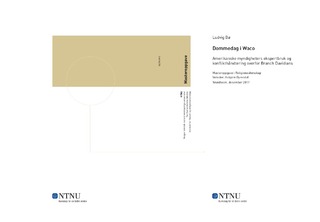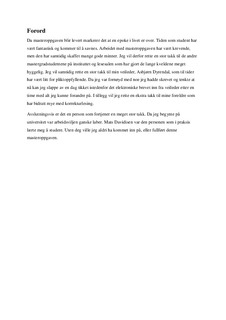| dc.description.abstract | This master thesis addresses the US authorities’ conflict with the Branch Davidians from the start of the investigation to the ending of the siege. The thesis is splitt into two main parts.
The first concerns the Bureau of Alcohol, Tobacco and Firearms (ATF) investigation of the Branch Davidians from May 1992 to the raid of the movement's property, Mount Carmel, February 28, 1993. This section takes a deep dive into the government's own reports and compares it with the academic research literature. The main focus is on what influenced the investigation, preferably stigmatization of marginal religious movements, the media, and the use of experts. There was an ongoing problem in ATF's investigation that they stigmatized Branch Davidians by referring to them as a "cult." The use of that word resulted in a negative attitude towards the movement that would not have existed if the ATF had referred them as a congregation. This point was reinforced by the media. With anticult activists and former members in the lead, they helped to mark Branch Davidians as something exclusively negative and dangerous. ATF was based largely on the same sources as the media. This meant that the investigation was not as objective as it should have been. The objectivity issue is particularly important given that ATF used the same experts as the media.
The second part addresses the FBI's Siege of Mount Carmel after taking over the responsibility from ATF from March 1 to April 19, 1993. In this section, I have taken note of how the FBI used the expertise of specialists to try and get a peaceful solution to the situation. One of the biggest problems of the FBI was that they characterized the siege as a hostage situation where Koresh holds the Branch Davidians as hostages. This meant that the FBI focused largely on invoking experts in behavioral science with knowledge of «common criminals». The FBI’s experts can in part be distinguished between experts on behavioral science and experts on religion. The FBI relied mainly on the work of the behavioral experts. Even though their analysis focused on Koresh as a criminal and not a religious leader, they still came up with multiple suggestions for the FBI’s negotiation department. However, much of these advise were ignored by the FBI. The experts on religion were opposed by both behavioral experts and the negotiating department. The negotiating department rejected the faith of Branch Davidians as «bible babble». Religion was the lifeblood of the Branch Davidians, and Koresh was their prophet. Because the FBI did not acknowledge this, they effectively rejected the opportunity for a successful negotiation.
In conclusion, I have looked at how the siege of Mount Carmel affected the community and the actions of the authorities after the siege. Special emphasis is placed on how the siege of Mount Carmel changed the social debate and how the government changed the training of federal agents. The assignment is concluded with a brief account of the government's siege of Montana Freemen. This siege is known as the government's rehabilitation after Waco. I explain how the authorities had learned from Waco and thus relate to the Freemen in a completely different way, resulting in a peaceful ending. | nb_NO |

